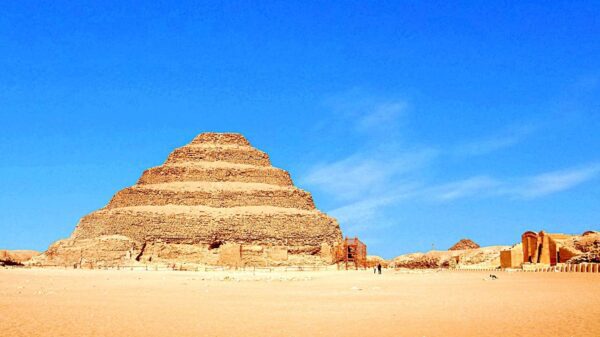

Sakkara Pyramid Marvel :5 Secrets Unveiled
Discovering the Sakkara Pyramid: A Journey into Egypt’s Ancient Past
When we think of Egypt, the iconic image of the Great Pyramids of Giza often comes to mind. However, Egypt’s rich history of pyramid building began long before these famous structures were erected. One of the most significant and fascinating sites in this ancient tradition is the Sakkara Pyramid, also known as the Step Pyramid of Djoser. Located in the vast necropolis of Sakkara, this pyramid marks a pivotal moment in architectural history. Let’s embark on a journey to explore the Sakkara Pyramid, uncovering its history, significance, and the intriguing stories it holds.
The Birth of Pyramid Building: The Sakkara Pyramid
The Sakkara Pyramid is renowned as the world’s first large-scale stone structure and the earliest colossal pyramid in Egypt. Built during the 27th century BCE for Pharaoh Djoser, it represents a groundbreaking shift from traditional mastaba tombs to the iconic pyramid shape. This transition was masterminded by the brilliant architect Imhotep, who is often credited as the first architect in recorded history.
Imhotep: The Visionary Behind the Sakkara Pyramid 
Imhotep was not only an architect but also a high priest, physician, and later deified as a god of wisdom and medicine. His innovative design for the Sakkara Pyramid involved stacking six mastabas of decreasing size on top of each other, creating the distinctive step-like structure. This design was revolutionary, setting the stage for the smooth-sided pyramids that would follow.
The Structure of the Sakkara Pyramid
Sakkara Pyramid stands at approximately 62 meters (203 feet) tall and was originally clad in polished white limestone, which would have gleamed in the sunlight. The pyramid’s base measures about 109 by 121 meters (358 by 397 feet), and it consists of six steps, each representing a mastaba.
The Complex Surrounding the Sakkara Pyramid
Sakkara pyramid is part of a larger mortuary complex that includes courtyards, temples, and shrines. This complex was designed to serve the pharaoh in the afterlife, reflecting the ancient Egyptians’ deep belief in life after death. The entire complex is surrounded by a massive limestone wall, with a single entrance leading to a colonnaded corridor that guides visitors into the heart of the site.
The Significance of the Sakkara Pyramid
Sakkara Pyramid is not just an architectural marvel; it also holds immense cultural and historical significance. It marks the beginning of the pyramid age, a period that would see the construction of some of the most famous monuments in human history. The pyramid’s design and construction techniques were pioneering, influencing subsequent generations of builders.
A Symbol of Royal Power: The Sakkara Pyramid
For Pharaoh Djoser, the Sakkara Pyramid was a symbol of his divine power and a testament to his reign. It was intended to ensure his safe passage to the afterlife and to solidify his legacy as a god-king. The grandeur of the pyramid and its complex reflected the central role of the pharaoh in ancient Egyptian society.
Discoveries and Excavations at the Sakkara Pyramid
Over the years, the Sakkara Pyramid has been the focus of numerous archaeological excavations, revealing a wealth of information about ancient Egyptian civilization. These excavations have uncovered artifacts, inscriptions, and burial sites that provide insights into the religious practices, daily life, and technological advancements of the time.
The Burial Chambers of the Sakkara Pyramid
Beneath the pyramid lies a network of tunnels and chambers, including the burial chamber of Pharaoh Djoser. Although the tomb was looted in antiquity, archaeologists have discovered remnants of Djoser’s sarcophagus and other burial goods. These findings offer a glimpse into the funerary practices and beliefs of the Old Kingdom.
Visiting the Sakkara Pyramid
For those planning a visit to Egypt, the Sakkara Pyramid is a must-see destination. Located about 30 kilometers (19 miles) south of Cairo, it is easily accessible and offers a fascinating glimpse into the early days of pyramid construction.
What to Expect When Visiting the Sakkara Pyramid
Visitors to the Sakkara Pyramid can explore the pyramid itself, as well as the surrounding complex. The site is less crowded than the Giza Plateau, allowing for a more intimate experience. As you wander through the ancient ruins, you can imagine the bustling activity that once filled this sacred space.
Tips for Visiting the Sakkara Pyramid
- Best Time to Visit: The cooler months from October to April are ideal for visiting, as the temperatures are more comfortable for exploring the site.
- Guided Tours: Consider hiring a knowledgeable guide to enhance your understanding of the pyramid’s history and significance.
- Photography: The pyramid and its complex offer stunning photo opportunities, especially during the golden hours of sunrise or sunset.
The Human Connection to the Sakkara Pyramid
What makes the Sakkara Pyramid truly special is the human connection it fosters. As you stand before this ancient structure, you can almost feel the presence of the people who built it over 4,600 years ago. From the laborers who toiled to the architects who designed it, the pyramid is a testament to human ingenuity and the enduring quest for immortality.
The Legacy of the Sakkara Pyramid
The Sakkara Pyramid’s legacy extends far beyond its physical structure. It represents a turning point in architectural history and a profound expression of the ancient Egyptians’ spiritual beliefs. Its influence can be seen in the subsequent pyramids of Giza and beyond, making it a cornerstone of Egypt’s rich cultural heritage.
In conclusion, the Sakkara Pyramid is a remarkable testament to the ingenuity and vision of ancient Egyptian civilization. Its history, architecture, and cultural significance make it a must-visit destination for anyone interested in exploring the wonders of Egypt. Whether you’re drawn by the stories of the past, the allure of ancient architecture, or the beauty of the desert landscape, the Sakkara Pyramid offers an unforgettable journey into the heart of Egypt’s ancient past.
Recent Posts
Edfu Temple :5 Reasons to Explore the Majestic Today
Discover 7 Amazing Features of Sinbad Hotel Egypt for 2024
Top 7 Reasons to choose Egypt Air Hospital in Egypt
All Categories
Tags


Thailand







